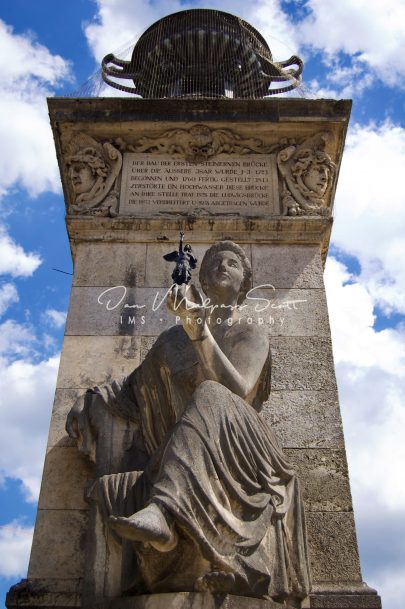![]()
Ludwigsbrücke bridge, Munich, Germany.
The Ludwigsbrücke is a road bridge over the Isar in Munich, which consists of two consecutive bridge structures separated by the Museum Island. Both parts of the bridge are arch bridges made of reinforced concrete that are clad with natural stone.
The Ludwigsbrücke connects Munich city center with Haidhausen and the Au. Coming from the Isartor, Zweibrückenstraße leads to the first part of the bridge, the Inner Ludwigsbrücke, which crosses the Great Isar to the Museum Island, on which the Deutsches Museum stands. The second bridge structure, the Äußere Ludwigsbrücke, leads from there over the Kleine Isar to Rosenheimer Strasse, from which the Inner Wiener Strasse branches off after a few meters at the Gasteig.
The Ludwigsbrücke is at a historically important place: This is where the Isarbrücke stood, with which Heinrich the lion redirected the salt trade from the Isarbrücke near Oberföhring to his sovereign territory in 1158. However, it is not clear whether this bridge was built at this time, which is often equated with the founding of the city of Munich, or whether goods traffic across the Isar initially led through a ford, since the Augsburger Schied of 1158 does not yet mention an Isar bridge near Munich , but only in 1180 in the Regensburg dispute. After the Föhringer Bridge was destroyed by Heinrich the Lion, the bridge near Munich remained the only navigable Isar bridge between Bad Tölz and Freising for a long time.
The original bridge was a simple, continuous, wooden pier or yoke bridge over the river, which did not then have the later formed island. Over the centuries that followed, the bridge was repeatedly damaged or destroyed by flooding and had to be rebuilt. A standardized construction with fixed dimensions for pillars and beams was therefore introduced, which gave the bridge the same appearance over the centuries. By the 15th century at the latest, the bridge had a small gatehouse with a guard, as can be seen in the 1493 view. After the bridge had to be renewed again in 1501, the Red Tower was built between 1517 and 1519 as a defense system towering over the bridge.
In 1705 the Isar had formed a gravel island, today’s Museum Island, so that the Great Isar ran to the west of the island and to the east of the island was the Small Isar and the Auer Mühlbach, which was still open there at the time. Between 1723 and 1725 part of the wooden bridge was replaced by an outer bridge over the Kleine Isar and the Auer Mühlbach. The pillars were made of stone, but the superstructure was again made of wood. The outer bridge over the Isar was only “vaulted” in 1759-1764 under the chief master builder Ignaz Anton Gunetzrhainer, i. H. built on the existing pillars as a stone arch bridge. After Gunetzrhainer’s death in 1764, the inner Isar bridge with three stone arches was rebuilt according to his plans in 1767-1772. The part of the bridge over the Auer Mühlbach was also called the Schwanenbrücke or Schleifferbrücke.
During fighting between Austrian and French troops, the Red Tower was set on fire on September 8, 1796 and largely destroyed, so that it later had to be demolished. Only the side buildings remained, which were used by the coppersmith Feßler and the tower inn, which existed until 1890.
On September 13, 1813, the part of the bridge leading over the Kleine Isar collapsed during a strong flood because the stone pillars erected in 1725 had been washed away. About 100 people died in the process. At first only a wooden emergency bridge was built. The then general director of the Bavarian road and hydraulic engineering von Wiebeking presented plans for a wooden, a stone and an iron bridge and King Maximilian I decided in favor of the stone one. When construction had already begun, concerns were raised about the intended span widths of around 30 m. New plans were submitted, e.g. by Georg von Reichenbach for a cast-iron tubular bridge, by his rival Joseph von Baader for a wrought-iron bridge and by the city building officer Carl Probst for a stone bridge. In October 1823, work began on the construction of the outer bridge based on Probst’s design with the architectural design additions made by Leo von Klenze.[1][2] At that time, the Auer Mühlbach had already been built over by the Rosenheimer Straße, but the bed of the Kleine Isar was a little wider than it is today. The bridge, which was inaugurated on May 3, 1828, was named Ludwigsbrücke in honor of the then King Ludwig I. The bridge now rested on a strong oak sill covered with planks. The bases of the pillars and abutments as well as the area of the walkways consisted of red sandstone that had been quarried in Neubeuern am Inn. The Nagelfluh came from Garmisch and Schäftlarn, from which the abutments consisted from the base to the arches. The piers themselves, the frontal arches, the main cornice and the railings were made of greenish-grey sandstone brought from Kelheim. The roadway was paved with boulders made of gneiss that had been picked up near Wangen in the Allgäu and near Neufahrn between Starnberg and Schäftlarn. The decoration between the breast railings was created in the royal iron foundry of Bodenwöhr.
In 1877, the inner bridge was widened by adding a cast iron construction.
In 1891-1892 the inner Ludwigsbrücke was replaced by a wider new building with three concrete arches and the outer bridge with four widened concrete arches


